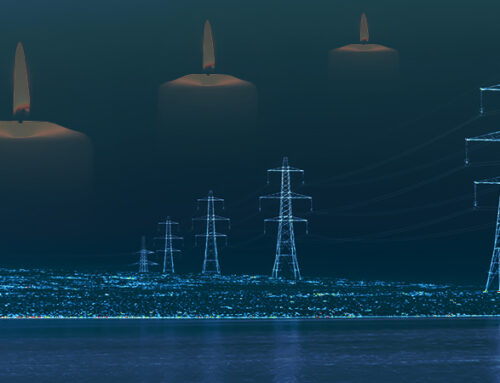Ofgem has published the latest strand in its ongoing work on making network charging arrangements fit for purpose against a backdrop of significant changes to the nature and use of both transmission and distribution networks.
It has issued a consultation into network access arrangements and forward-looking charges, and whether a Significant Code Review (“SCR”) should be undertaken to reform these areas. This would sit alongside the ongoing SCR into recovery of residual network costs, known as the Targeted Charging Review.
The impact of the changes Ofgem is considering could see:
- Greater alignment in network charging for distribution and transmission-connected generation, which would see small distributed generators paying a share of transmission charges from which they are currently exempt;
- More location-based charging at the distribution level, that would end the situation where distribution-connected generators receive benefits when in reality they are imposing costs on the network;
- Moves away from charging based on consumption in triad periods for demand customers, to fixed time of use windows, such as the bands used for DUoS charges, or capacity-based charging;
- Moves away from charging new distribution-connected generators for local network reinforcement, removing a key barrier to entry for new embedded generation, alongside new firmness/curtailment arrangements;
- Development of “use-it-ot-lose-it” / “use-it-or-sell-it” and trading arrangements for network access rights;
- Wider choice for domestic consumers with uniform (regulated) basic demand provision supplemented by a range of options for higher levels of demand with varying degrees of flexibility.
If the review goes ahead, Ofgem expects to launch it by the end of 2018 and conclude by early 2020, with any resulting code modifications being implemented by April 2022 and taking effect by April 2023.
Ofgem’s three main priorities
Enabling growth in demand, particularly stemming from new low-carbon technologies, while managing constraints on the networks
Increased use of electric vehicles (“EVs”) and heat pumps could place strains on network capacity at peak times, leading to a need for increased network capacity and higher network costs – Ofgem believes there could be congestion on the network as early at 2025, potentially leading to reinforcement costs of around £400 million (NPV to 2040). Ofgem believes that network access and charging arrangements could be adapted to provide better signals to incentivise load shifting away from peak times.
Managing constraints on the distribution networks as a result of growth in distribution-connected generation
The growth in embedded generation is already leading to constraints on the amount of electricity that can be exported by such generators onto existing networks. There is now 28 GW of distribution-connected generation (compared to 75 GW on the transmission system), potentially rising to between 37 GW and 71 GW by 2030. Large queues to connect are already emerging – there were 20 GW of accepted connection offers (some of which were speculative) in 2016.
Ofgem believes that current connection arrangements do not signal the impact of locating at different points on the network strongly enough, and that changes would lead to more efficient use of networks. Consulting firm Baringa has estimated that up to £1.2 billion of network reinforcement costs could be avoided through use of flexible connections by 2040.
An effective interface between transmission and distribution arrangements
The growth in generation and demand-side response at the distribution level is increasing the interaction between the transmission network and distribution networks, with more electricity being exported from the distribution networks onto the transmission network. Current charging arrangements for these networks have been developed separately and have some differences which could distort competition and do not necessarily adequately reflect the impact distribution network users have on the transmission system.

Wider network charging context
Ofgem’s work on network access and forward-charging is part of a wider examination of network charging arrangements, which also includes the Targeted Charging Review (“TCR”) into residual charging, and changes to settlement arrangements. Currently, network and system operator charges amount to around £10 billion per year, of which around half is recovered through residual charges.
One of the key motivations of the TCR was the observation that market participants were changing their behaviours in response to residual charges, and this was contrary to Ofgem’s intentions that residual charges should not provide forward-looking signals. The quantum of residual charges and their proportion of the whole has grown over recent years, making these effects more significant.
Reform of access arrangements and forward-looking charges may well change this, which is why Ofgem has delayed publication of its minded-to document on the TCR until the autumn, after the access/forward-charging consultation closes. However, Ofgem is concerned that the size of the customer detriment caused by the current approach to residual charge recovery means that it should not wait until the review of forward-looking charges is finalised before addressing the issue.
The relationship between these charges at the transmission and distribution levels is shown below:

So far, in its work on residual charging, Ofgem has determined that these charges should be met by demand, with charges based on gross rather than net demand, and capacity rather than import/export-based.
Ofgem has three over-arching principles it is applying when assessing how networks should be paid for: reduction of harmful market distortions, practicality and fairness.

Ofgem’s initial thinking on access and forward-looking charging arrangements
Ofgem has identified a number of features which it considers will help to meet its priorities:
- Allocation of network capacity based on users’ needs – this will mean capacity should be allocated to those that value it most.
- Ensuring network users face cost-reflective charges for network access and/or usage, ie their costs (or income) from accessing the network reflect the incremental costs and benefits they confer on the system in both their investment and dispatch decisions.
- Establishing a level playing field across different types of users, technologies or asset types (eg between users seeking connections at different voltages), avoiding undue distortions.
- Implementing simple, transparent and predictable forward-looking charges that provide a reliable basis for user decision-making.
- Ensuring the risks of developing and allocating network capacity are allocated to the party best placed to manage them, with network users providing appropriate commitment towards investment they drive.
- Provision of high quality information about where and when new network capacity is needed to enable timely and efficient network investment. This includes helping identify where alternative solutions, such as new sources of flexibility, can offer better value.
- Safeguards that recognise electricity as an essential service, and take account of the needs of vulnerable consumers.
Issues with existing arrangements
Differences in network access arrangements may cause distortions
Access to the distribution and transmission networks are defined differently, and vary according to different types of users. In general, larger generators connection to the transmission network will be determined by their Transmission Entry Capacity (“TEC”); their connection charges will be paid either upfront or across a period of up to 40 years, and their access will be firm – in other words cannot be curtailed other than by agreement through the Balancing Mechanism. Smaller generators and demand connected to the transmission system have less well-defined access arrangements.
Larger distribution-connected users (both demand and generation) have agreed entry or exit capacity, and can opt for flexible connection arrangements as an alternative to paying for network reinforcements if connecting in a constrained area, however this gives the DNO the right to curtail their access without any payment.
Many households do not have clearly defined access rights – in practice households’ network access is limited by their fuse size, with DNOs designing networks on the assumption that they will not all use up to their entire fuse size at the same time.
Connection charges create barriers to entry
Transmission connection charges are “shallower” than at the distribution level in that the cost of wider reinforcements and some sole use assets are recovered via Use of System (“UoS”) charges levied on all system users. Distribution connection charges are paid before the connection is made live and the connection customer must pay for its own sole-use assets, as well as a proportion of any wider reinforcement (up to one voltage above their point of connection).
The forward-looking component of UoS charges is intended to reflect network users’ incremental impact on network costs, including current and future investment and reinforcement (that is not recovered through connection charges). Different models are used to calculate UoS charges at different voltages.
In particular, distribution UoS (“DUoS”) charges were not designed primarily with distributed generation in mind, as system demand was historically the main driver of distribution network cost. In the DUoS methodology, generation is treated as negative demand, and generally receives a credit rather than a charge. In some areas of the network which are dominated by embedded generation, generators are receiving benefits through DUoS when in fact they are imposing costs on the network.
“We want developers to respond to signals that reflect the economic reality, not the peculiarities of the regulations.”
While distribution-connected generators benefit under DUoS charging, they face disadvantages relative to transmission-connected generation in other areas: they do not have the option of “financially firm” network access, and the routes by which such generators are able to benefit from financially firm/Connect and Manage at the transmission level are insufficiently clear.
The connection charging boundary currently requires distribution-connected generators to pay a share of any network reinforcement (up to one voltage up), required when connecting, while this is not the case for transmission-connected generation. To date, the extent to which embedded generators have paid connection charges reflecting wider reinforcement costs has been very limited, but this could become a bigger issue in the future if distribution networks become increasingly constrained.
Different treatments of generators for use of system charging
Transmission system UoS (“TNUoS”) charges typically treat small distribution-connected generators differently to larger generators – smaller embedded generators generally do not pay TNUoS in zones where the transmission connected generation face positive charges and are charged based on their generation during triad periods rather than on a nominated TEC.
Additionally, distributed generation does not pay any local UoS charges, and smaller distribution-connected generators do not pay Balancing System UoS (“BSUoS”), in contrast with larger distribution-connected and transmission-connected generation.
On-site generation is treated as negative demand and charged based on the amount generated during triad periods, whereas larger generation is charged based on their agreed TEC.
A number of other sub-optimal features of current arrangements were also identified:
- There are potential distortions to generation investment decisions as a result of inadequate forward-looking charges about transmission costs, most notably, in relation to the charging of costs associated with the Connect and Manage policy. In addition, the TNUoS locational model does not take into account where some areas of the network have more spare capacity than others.
- There is a risk that network operators invest in assets that are subsequently under-utilised, since investment decisions are based on forecasts that may prove to over-state the need – the National Grid 2018 Future Energy Scenarios suggest that transmission-connected generation may range from 74 GW to 88 GW by 2025 which represents a sizeable variation in utilisation of the transmission network.
- At the distribution level, DNOs may make significant investments based on current forecasts for when, where and how EV users are going to charge their EVs, but future innovation (eg induction charging or autonomous vehicles) could mean that these forecasts prove to be wrong and these assets could become stranded.
Reforming network access rights
Ofgem would like to see reforms to network access rights that:
- Clarify access rights and improve choice for small users, including households:
This could involve requiring small users to specify the level of capacity they require, with a minimum standard ‘core’ level and enabling them to choose from a range of options (eg varying in firmness or time of access) above this level. An alternative approach could involve placing a principles-based obligation on suppliers or another third party to determine the type of access that a small user needs for all their usage, requiring them to ensure they made that recommendation in line with a customer’s best interests.Many households will have limited choice around their more essential needs, but some may have the ability to be flexible in their consumption eg in relation to EV charging. A core level of access could help ensure basic needs are met while protecting consumers from inappropriate access arrangements for these basic needs. Above this level, consumers could choose between continuous, higher level usage, or more flexible options such as off-peak or interruptible access, with differential charging valuing these alternatives appropriately.
- Improved definition and choice of access for larger users:
Ofgem sees merit in developing options to improve the definition and choice of: firmness of access rights ie when access might be curtailed and whether payments will be available if it is; time-profiled access rights eg off-peak or seasonal access rather than year round; and short-term access rights. Ofgem is also seeking views on the value and feasibility of options for defined long-term access rights for a fixed multi-year duration, and local or shallow access rights such as access to only trade over the local network.
 Access rights could be defined to apply to the whole system, allowing access to the entire distribution and transmission system, and hence all GB markets, or they could be “local” to a specific geographical area or “shallow” to a specific voltage level.
Access rights could be defined to apply to the whole system, allowing access to the entire distribution and transmission system, and hence all GB markets, or they could be “local” to a specific geographical area or “shallow” to a specific voltage level.
Ofgem believes that the development of local or shallow access rights could provide a useful signal about the benefits of matching generation and demand locally.
However, development of local access rights could be very complex and the creation of local access rights may have the effect of splitting GB’s single market into multiple local markets. The use of forward-looking charges might provide an equivalent signal more simply, and Ofgem’s provisional view is that a charging based approach is likely to be preferable.
Overall, Ofgem’s view is that the stronger the emphasis on choice of access rights, the greater the case for capacity-based charges – charges that are based on the capacity requested by the users in kW rather than usage charges based on the volume of electricity consumed in kWh.
- Improved allocation of access rights:
Access rights could also be allocated through auctions rather than on a first-come-first-served basis which is currently the case, although Ofgem is not currently considering universal auctions for the initial allocation of access rights. The use of ‘targeted’ auctions for the initial allocation under certain situations (eg where significant queues exist), could help ensure those that value access most are able to obtain it and provide better signals to network operators about the need for new network capacity.
“Work on reforming these areas is welcome though we would argue overdue, for example as any solar developer will tell you the system for connecting to the grid has almost become a lottery and must be addressed,”
– Frank Gordon, policy manager, Renewable Energy Association
However, better definition of access rights and a decision on the connection-charging boundary would be needed, before auctions could be designed, and as the development of targeted auctions is likely to be complex, Ofgem believes there will be benefits in considering this across both transmission and distribution together. For this reason, Ofgem is not proposing to make this a priority at this stage.
Similarly, extending the benefits of the allocation approach under Connect and Manage to distribution networks would require the establishment of firm access rights at distribution which is unlikely to be achievable in the short-term, due to the need to develop new network planning standards.
Ofgem is also considering developing new access conditions such as “use it or lose it” or “use it or sell it” to increase the utilisation of the existing capacity by reducing capacity hoarding, and enabling holders of access rights to trade them with others, for example to reduce their curtailment.
Reforming forward-looking charges
Ofgem has identified three priority areas to make better use of existing network capacity, support more effective competition between users and achieve a more efficient allocation of risk:
- A comprehensive review of forward-looking DUoS charges:
Ofgem is proposing a comprehensive review of forward-looking DUoS charging methodologies with the following areas of focus:
- Introducing greater granularity to Common Distribution Charging Methodology for low and high voltage distribution networks so charges are more reflective of actual local network conditions. This could mean embedded generators in generation-dominated areas could pay a charge rather than receive a credit, while demand could receive a credit. Building comprehensive network models to allow load flow modelling may be difficult to achieve at lower voltages so alternative approaches such as dividing the distribution system into generation or demand dominated zones may be needed provide more locational signals. The review will consider whether there should be limits on the extent to which small (eg domestic) usage should be subject to cost-reflective locational signals.
- The Extra High Distribution Charging Methodology for extra-high voltages could also move to a zonal approach, or be aligned with the approach used for TNUoS forward-looking charging signals.
- The balance between usage-based charges, including time-of-use charges, and capacity-based charges should be considered, to better reflect the costs or benefits created by users’ specific access choices. For example, if a user opts for time-profiled off-peak access to the network, then capacity-based charges would better reflect the reduction in reinforcement costs, than a volumetric time-of-use charge.For domestic users cost-reflective charges may have limited benefits as users have less ability to respond to locational signals. There is also a risk that greater locational variability of network charges may adversely impact vulnerable consumers. The approach will need to be robust to the development of newer models and technologies, such as vehicle-to-grid services which may mean typical demand users also export electricity onto the networks.
- A review the distribution connection charging boundary:
The existing shallow-ish connection boundary sends a locational signal to new network users about the most efficient location to connect, however the potential high upfront cost of connection may act as a deterrent.Moving to a shallower connection charging boundary could reduce these barriers to entry, as new connections would no longer principally bear the costs of any reinforcement.However, reducing connection charges in this way would only work if better locational signals were sent through ongoing DUoS charges. More locationally varying UoS charges would mean existing users face more accurate incentives to provide flexibility to offset the need for reinforcement.Consumers rather than the connecting party would bear the risk of funding new connected assets over their lifetime, so Ofgem would like to see consideration being given to new user commitment arrangements, similar to those at the transmission level to help reduce risk of stranded assets.
- A more focused review of forward-looking TNUoS charges.
Generation connected to distribution networks can still impact flows across the transmission network as there can be exports of electricity from distribution networks onto the transmission network which contribute to transmission network constraints. They can also reduce transmission network constraints when they locate in areas where demand exceeds generation.There are two key differences in how small distribution-connected generators are treated for TNUoS charges: they are treated as negative demand and hence receive payments/credits on the basis of demand during the ‘triad periods’, whereas larger generators are charged based on their TEC; and to prevent incentives to reduce output during peak periods, a “floor at zero” means they don’t pay TNUoS charges when they are adding to transmission network flows (and hence costs).Aligning the charging structures for small embedded generators with those of larger generators would ensure all generators receive the same transmission forward-looking charges. They would receive TNUoS credits in zones where they are expected to reduce long-term transmission costs, and pay TNUoS charges in zones where they are expected to increase long-term costs.The removal of the cap on TNUoS charges would suggest moving to a capacity-based charge for distribution-connected generators otherwise there would be a significant incentive for them to avoid generating during triad periods.
Changing the forward-looking TNUoS charging of demand
Ofgem is seeking views on whether the proposed review should also include the basis of the forward-looking TNUoS charging of demand. This could result in charging demand based on their capacity requirement rather than usage, or moving away from charging based on demand during triad periods to fixed time of use windows.
The current approach of charging demand customers based on their usage during triad periods may be introducing uncertainty, as the timing of triads is increasingly difficult to predict, and they may not always align with periods of peak network constraints in particular areas. However, where they do align, Ofgem believes the demand reduction stimulated by the triad approach has value, particularly when the customers responding to triad are not participating in the Balancing Mechanism and so would not otherwise provide demand response.
On-site generation is charged as negative demand based on generation during triad periods, whereas larger generators incur a capacity-based charge, which could be introducing distortions to both investment and operational decisions between on-site and other generation.

Implications of the changes
Distribution-connected generators are likely to see the biggest changes if Ofgem’s initial thinking eventually translates into code changes. On the plus side, it would become easier and less expensive for them to connect to distribution networks, and there could be a wider range of connection options with different levels of firmness. Network access could also be traded, allowing curtailments to be managed more effectively.
On the downside, their ongoing use-of-system charges would increase, with new obligations to contribute to the costs of the transmission system. This could adversely effect the economics of generators that have already paid the costs of local reinforcement and then also face higher ongoing costs to pay for future reinforcements elsewhere in the network. Affected generators are likely to lobby hard to avoid this and allowing a grace period to reflect the amortisation of reinforcement costs already paid may be fair in such cases.
The introduction of location-based DUoS charging to reflect whether generation is being added in areas where there is already a surplus of generation will increase incentives for efficient location of new embedded generation, but may adversely impact existing embedded generation. However, with a shallower access regime, it may become easier for generators to move. (In the recent court case on changes to the transmission demand residual charge, the Claimants asserted that it was difficult for small embedded generation to move location, although on being shown a picture of such assets, the Judge observed that they were constructed in 20-foot containers that are themselves easily transportable.)
 Designing changes to domestic arrangements will require care. In a recent Energy UK briefing on the subject, a speaker from Citizens Advice observed that demographic changes will result in more consumers being considered vulnerable. Higher charges at peak times to incentivise EV users to charge at other times of day may cause vulnerable consumers to turn off their heating to save costs. Ofgem’s suggestions of separating the basic need for electricity for heating, lighting and cooking from higher consumption such as EV charging is a good one, but may not be easy to implement.
Designing changes to domestic arrangements will require care. In a recent Energy UK briefing on the subject, a speaker from Citizens Advice observed that demographic changes will result in more consumers being considered vulnerable. Higher charges at peak times to incentivise EV users to charge at other times of day may cause vulnerable consumers to turn off their heating to save costs. Ofgem’s suggestions of separating the basic need for electricity for heating, lighting and cooking from higher consumption such as EV charging is a good one, but may not be easy to implement.
Work will also be needed to educate consumers more broadly on the benefits of time-of-use charging – recent media stories about “surge pricing” is encouraging consumers to see it as a conspiracy on the part of suppliers to hike prices at expensive times (bizarrely suggesting Christmas and Easter will see higher prices due to the extra use of ovens, ignoring the hugely more significant impact of lower industrial demand), rather than a tool to optimise use of networks.
It seems likely that alongside these changes there will need to be a need to improve and extend metering arrangements – it’s difficult for system operators to plan network investments without visibility on the assets connected at different levels including on-site generation.
The last few years have seen significant changes to the electricity system, and the pace of change is unlikely to slow. New technologies such as EVs and batteries have the potential to completely change the size and use of electricity networks, which are also being used in different ways with the growth in demand-side response.
Ofgem’s network charging initiatives are a necessary step in responding to these changes and ensuring electricity networks are developed and managed in a cost-effective way for the benefit of its users. However, this is a challenging and complex exercise, and inevitably there will be winners and losers in whatever decisions are eventually made.






The business of electricity management has obviously become much more complex with both the introduction of highly variable green energy generation, and with the understanding that the Grid and Distribution networks can be managed easily by every input/export node being controlled centrally, and that there is fairness in this world for everyone.
However I have failed to see in all this some very basic considerations of simplicity, of continuity, and of costs. Nor have I seen any reflection of what do users actually want of The System.
As a chartered engineer and from my 40 years of work experience around the world the systems that work best are simple, adaptable and easily managed. As a property and car owner all I want, as I am sure the majority of similar people, is to be able to budget for (usually) steady costs in maintaining and using those assets of mine.
Furthermore, being rurally located I do not want any reliance on electronic communications to manage those assets as, in this changing country of ours and with ever increasing demands upon its ‘services’, outages of electricity and communications persist despite recent more local system ‘upgrades’.
As to fairness, that is sheer utopia, and from what I have seen there is risk that the future scenario will make the current position worse.
I think there are a few issues here. One is that if everyone wanted to use all the electricity they want whenever they want it, for example to charge their EVs when they get home from work during the evening peak, then networks will need to be significantly larger than they are now. While that may be simple, it would also be expensive.
Another issue is that as some businesses and potentially households install on-site generation and batteries and engage in load shifting, the current means of recovering network costs will mean they are disproportionally borne by those who are unable to do those things, often including the most vulnerable consumers, which is clearly unfair.
While it might be difficult to design a system that is fair, I think it’s right for Ofgem to try to make sure the level of unfairness doesn’t become too great, particularly for vulnerable consumers.
However, I also think the notion that the system has at any time enjoyed being simple, reliable and low cost is wide of the mark – although the traditional system was broadly simple and reliable, there was a lot of over capacity which inflated costs. With de-carbonisation the system is significantly more complex, reliability is harder to achieve and costs could easily get out of control.